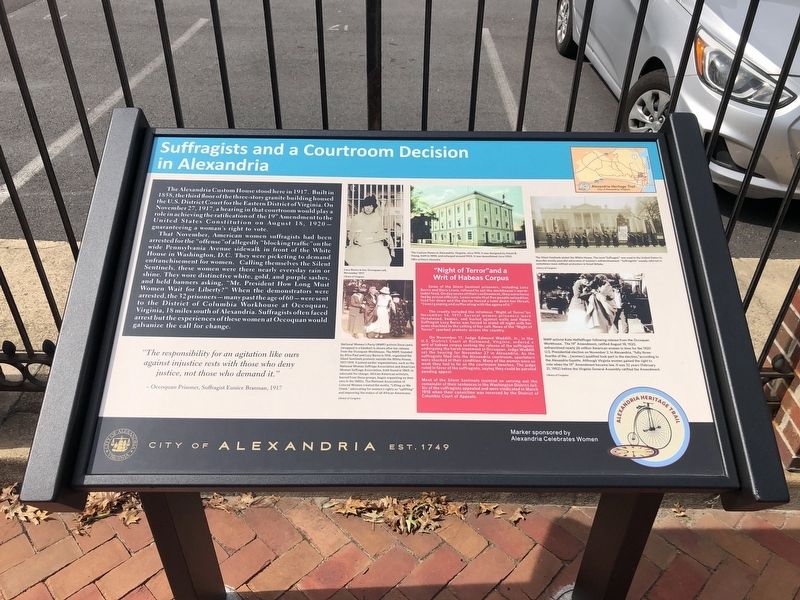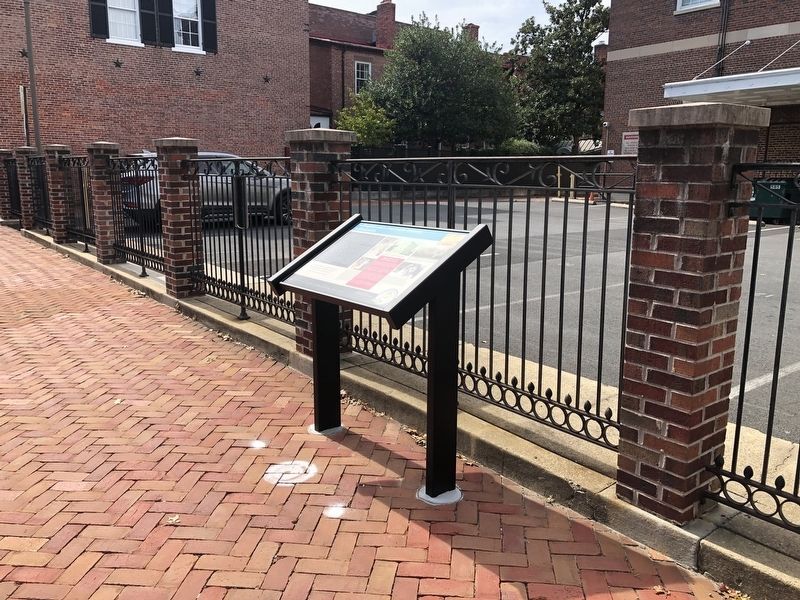Old Town in Alexandria, Virginia — The American South (Mid-Atlantic)
Suffragists and a Courtroom Decision in Alexandria
Alexandria Heritage Trail
— City of Alexandria, est. 1749 —

Photographed By Devry Becker Jones (CC0), September 25, 2021
1. Suffragists and a Courtroom Decision in Alexandria Marker
The Alexandria Custom House stood here in 1917. Built in 1858, the third floor of the three-story granite building housed the U.S. District Court for the Eastern District of Virginia. On November 27, 1917, a hearing in that courtroom would play a role in achieving the ratification of the 19th Amendment to to the United States Constitution on August 18, 1920 — guaranteeing a woman's right to vote.
That November, American women suffragists had been arrested for the "offense" of allegedly "blocking traffic" on the wide Pennsylvania Avenue sidewalk in front of the White House in Washington, D.C. They were picketing to demand enfranchisement for women. Calling themselves the Silent Sentinels, these women were there nearly everyday rain or shine. They wore distinctive white, gold, and purple sashes and held banners asking, "Mr. President How Long Must Women Wait for Liberty?" When the demonstrators were arrested, the 32 prisoners — many past the age of 60 — were sent to the District of Columbia Workhouse at Occoquan, Virginia, 18 miles south of Alexandria. Suffragists often faced arrest but the experiences of these women at Occoquan would galvanize the call for change.
"The responsibility for an agitation like ours against injustice rests with those who deny justice, not those who demand it."
— Occoquan Prisoner, Suffragist Eunice Brannan, 1917
[Sidebar:]
"Night of Terror" and a Writ of Habeas Corpus
Some of the Silent Sentinel prisoners, including Lucy Burns and Dora Lewis, refused to eat the workhouse's worm-laden food. On day seven of their confinement, they were force fed by prison officials. Lewis wrote that five people seized her, held her down and the doctor forced a tube down her throat, "(was) gasping and suffocating with the agony of it."
The cruelty included the infamous "Night of Terror" on November 14, 1917. Several women prisoners were threatened, beaten, and hurled against walls and floors. Suffragist Lucy Burns was forced to stand all night with her arms shackled to the ceiling of her cell. News of the "Night of Terror" sparked protests across the country.
On November 17, Judge Edmund Waddill, Jr., in the U.S. District Court at Richmond, Virginia, ordered a writ of habeas corpus seeking the release of the suffragists undergoing the harsh treatment at Occoquan. Judge Waddill set the hearing for November 27 in Alexandria. As the suffragists filed into the Alexandria courtroom, spectators were shocked at their condition. Many of the women were so weak they had to lie on the courtroom benches. The judge ruled in favor of the suffragists, saying they could be paroled pending

Photographed By Devry Becker Jones (CC0), September 25, 2021
2. Suffragists and a Courtroom Decision in Alexandria Marker
Most of the Silent Sentinels insisted on serving out the remainder of their sentences in the Washington District Jail. Six of the suffragists appealed and were vindicated in March 1918 when their conviction was reversed by the District of Columbia Court of Appeals.
[Captions:]
Lucy Burns in her Occoquan cell, November 1917
National Women's Party (NWP) activist Dora Lewis (wrapped in a blanket) is shown after her release from the Occoquan Workhouse. The NWP, founded by Alice Paul and Lucy Burns in 1916, organized the Silent Sentinels protests outside the White House, 1917-1919. It joined earlier organizations, such as the National Woman Suffrage Association and American Woman Suffrage Association, both found in 1869, to advocate for change. African American activists, barred from these groups, began organizing on their own in the 1880s. The National Association of Colored Women created the motto, "Lifting as We Climb," advocating for women's rights as "uplifting" and improving the status of all African Americans.
The Custom House in Alexandria, Virginia, circa 1919. It was designed by Ammi B. Young, built in 1858, and enlarged around 1903. It was demolished circa 1930.
The Silent Sentinels picket the White House. The term "Suffragist" was used in the United States to describe mostly peaceful advocates of women's enfranchisement. "Suffragette" usually referred to sometimes more militant protesters in Great Britain.
NWP activist Kate Heffelfinger following release from the Occoquan Workhouse. The 19th Amendment, ratified August 18, 1920, enfranchised nearly 26 million American women in time for the 1920 U.S. Presidential election on November 2. In Alexandria, "fully three-fourths of the …[women] qualified took part in the eletion," according to the Alexandria Gazette. Although Virginia women gained the right to vote when the 19th Amendment became law, it was 32 years (February 21, 1952) before the Virginia General Assembly ratified the Amendment.
Erected by the City of Alexandria; marker sponsored by Alexandria Celebrates Women.
Topics and series. This historical marker is listed in these topic lists: Civil Rights • Government & Politics • Law Enforcement • Women. In addition, it is included in the Virginia, The City of Alexandria series list. A significant historical month for this entry is March 1918.
Location. 38° 48.214′ N, 77° 2.773′ W. Marker is in Alexandria, Virginia. It is in Old Town. Marker is on South St. Asaph Street just south of Prince Street, on the right when traveling south. Touch for map. Marker is at or near this postal address: 202 S St Asaph St, Alexandria VA 22314, United States of America. Touch for directions.
Other nearby markers. At least 8 other markers are within walking distance of this marker. The Ticer House (within shouting distance of this marker); John Douglass Brown House (within shouting distance of this marker); 511 Prince Street (within shouting distance of this marker); Brigadier General Montgomery D. Corse, CSA (about 300 feet away, measured in a direct line); Stabler-Leadbeater House (about 300 feet away); Portner's (about 300 feet away); The Methodist Episcopal Congregation of Alexandria (about 400 feet away); The Lyceum (about 400 feet away). Touch for a list and map of all markers in Alexandria.
Credits. This page was last revised on May 25, 2023. It was originally submitted on September 27, 2021, by Devry Becker Jones of Washington, District of Columbia. This page has been viewed 208 times since then and 29 times this year. Photos: 1, 2. submitted on September 27, 2021, by Devry Becker Jones of Washington, District of Columbia.